Dissertation: Diabetes Type 2 Risks in UK Adults Aged 40-60
VerifiedAdded on 2021/09/14
|61
|17864
|108
Thesis and Dissertation
AI Summary
This dissertation investigates the risk factors associated with the development of Type 2 Diabetes (T2D) among Black African and Asian adults aged 40-60 in the United Kingdom. The research employs a systematic review methodology, analyzing 15 relevant research papers from databases like OVID, MedLine, CINAHL, and Cochrane Library, published between 2008 and 2017. The study identifies three key themes: the influence of social determinants of health, the impact of smoking and excessive alcohol consumption, and the role of reduced physical activity in increasing T2D susceptibility. The findings highlight the significant impact of lifestyle choices, including diet, exercise, and substance use, on the development of the disease. The dissertation concludes with recommendations for promoting self-management strategies and raising awareness to encourage healthier lifestyles and dietary preferences to mitigate the prevalence of T2D within the target population.
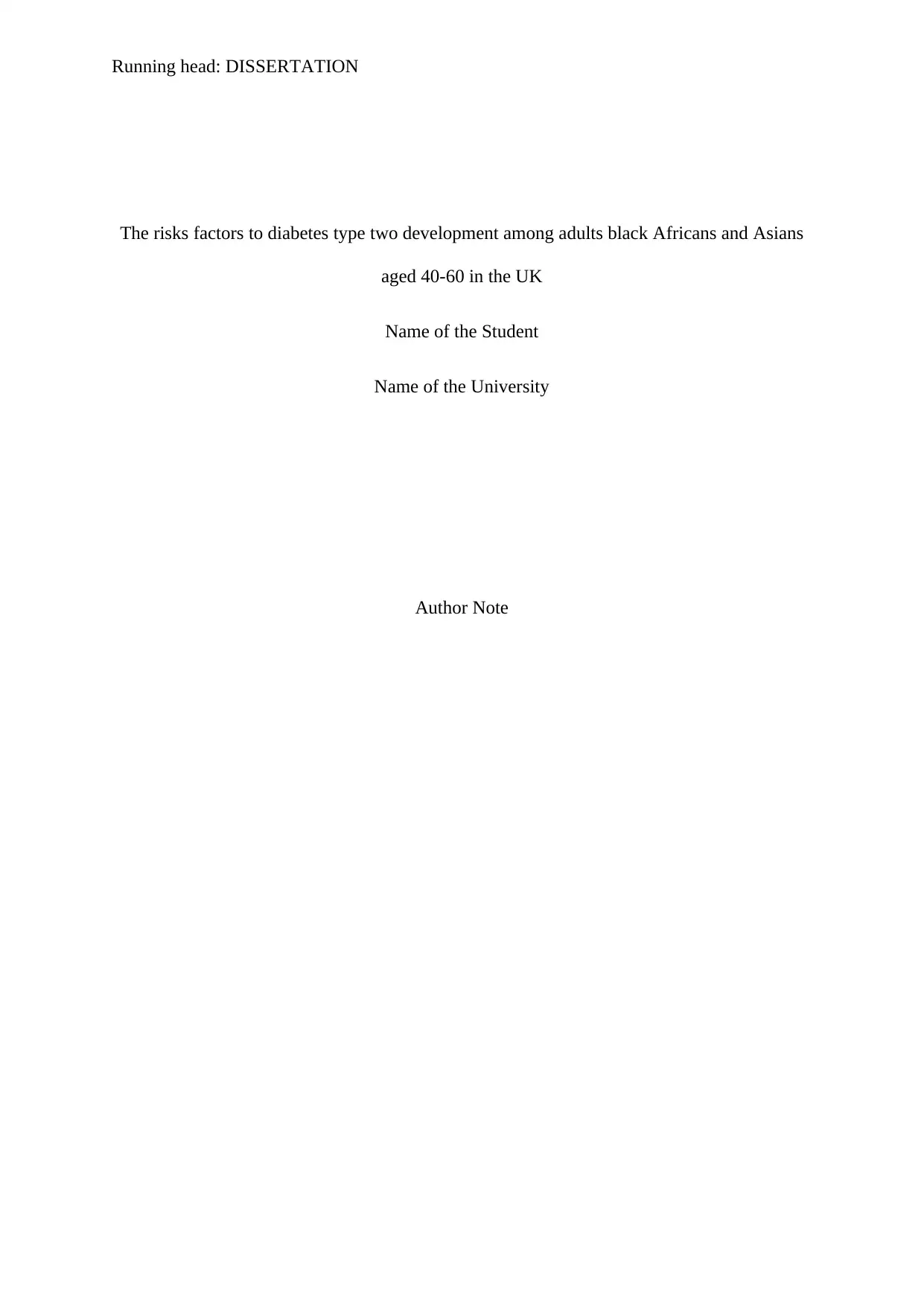
Running head: DISSERTATION
The risks factors to diabetes type two development among adults black Africans and Asians
aged 40-60 in the UK
Name of the Student
Name of the University
Author Note
The risks factors to diabetes type two development among adults black Africans and Asians
aged 40-60 in the UK
Name of the Student
Name of the University
Author Note
Paraphrase This Document
Need a fresh take? Get an instant paraphrase of this document with our AI Paraphraser
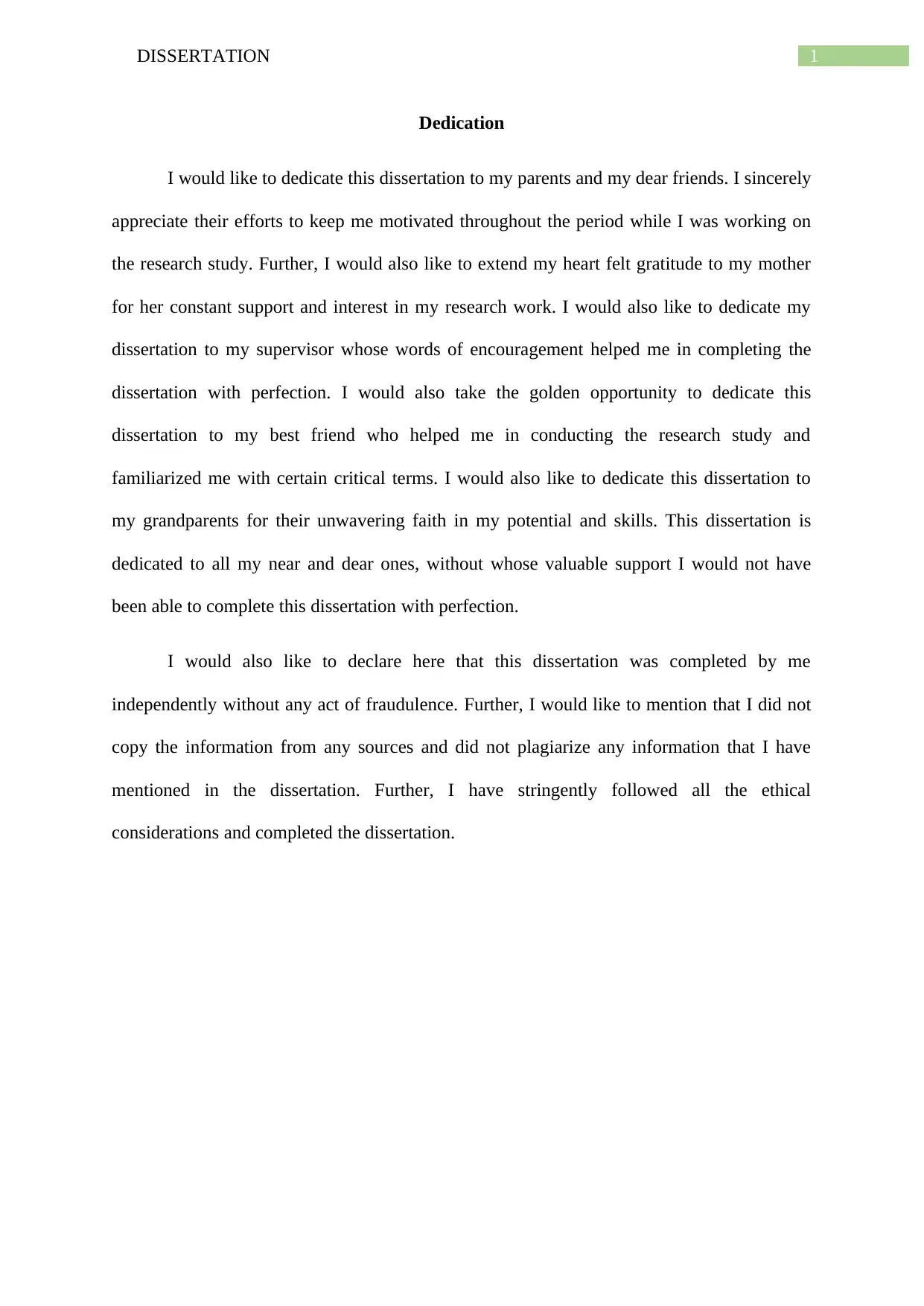
1DISSERTATION
Dedication
I would like to dedicate this dissertation to my parents and my dear friends. I sincerely
appreciate their efforts to keep me motivated throughout the period while I was working on
the research study. Further, I would also like to extend my heart felt gratitude to my mother
for her constant support and interest in my research work. I would also like to dedicate my
dissertation to my supervisor whose words of encouragement helped me in completing the
dissertation with perfection. I would also take the golden opportunity to dedicate this
dissertation to my best friend who helped me in conducting the research study and
familiarized me with certain critical terms. I would also like to dedicate this dissertation to
my grandparents for their unwavering faith in my potential and skills. This dissertation is
dedicated to all my near and dear ones, without whose valuable support I would not have
been able to complete this dissertation with perfection.
I would also like to declare here that this dissertation was completed by me
independently without any act of fraudulence. Further, I would like to mention that I did not
copy the information from any sources and did not plagiarize any information that I have
mentioned in the dissertation. Further, I have stringently followed all the ethical
considerations and completed the dissertation.
Dedication
I would like to dedicate this dissertation to my parents and my dear friends. I sincerely
appreciate their efforts to keep me motivated throughout the period while I was working on
the research study. Further, I would also like to extend my heart felt gratitude to my mother
for her constant support and interest in my research work. I would also like to dedicate my
dissertation to my supervisor whose words of encouragement helped me in completing the
dissertation with perfection. I would also take the golden opportunity to dedicate this
dissertation to my best friend who helped me in conducting the research study and
familiarized me with certain critical terms. I would also like to dedicate this dissertation to
my grandparents for their unwavering faith in my potential and skills. This dissertation is
dedicated to all my near and dear ones, without whose valuable support I would not have
been able to complete this dissertation with perfection.
I would also like to declare here that this dissertation was completed by me
independently without any act of fraudulence. Further, I would like to mention that I did not
copy the information from any sources and did not plagiarize any information that I have
mentioned in the dissertation. Further, I have stringently followed all the ethical
considerations and completed the dissertation.
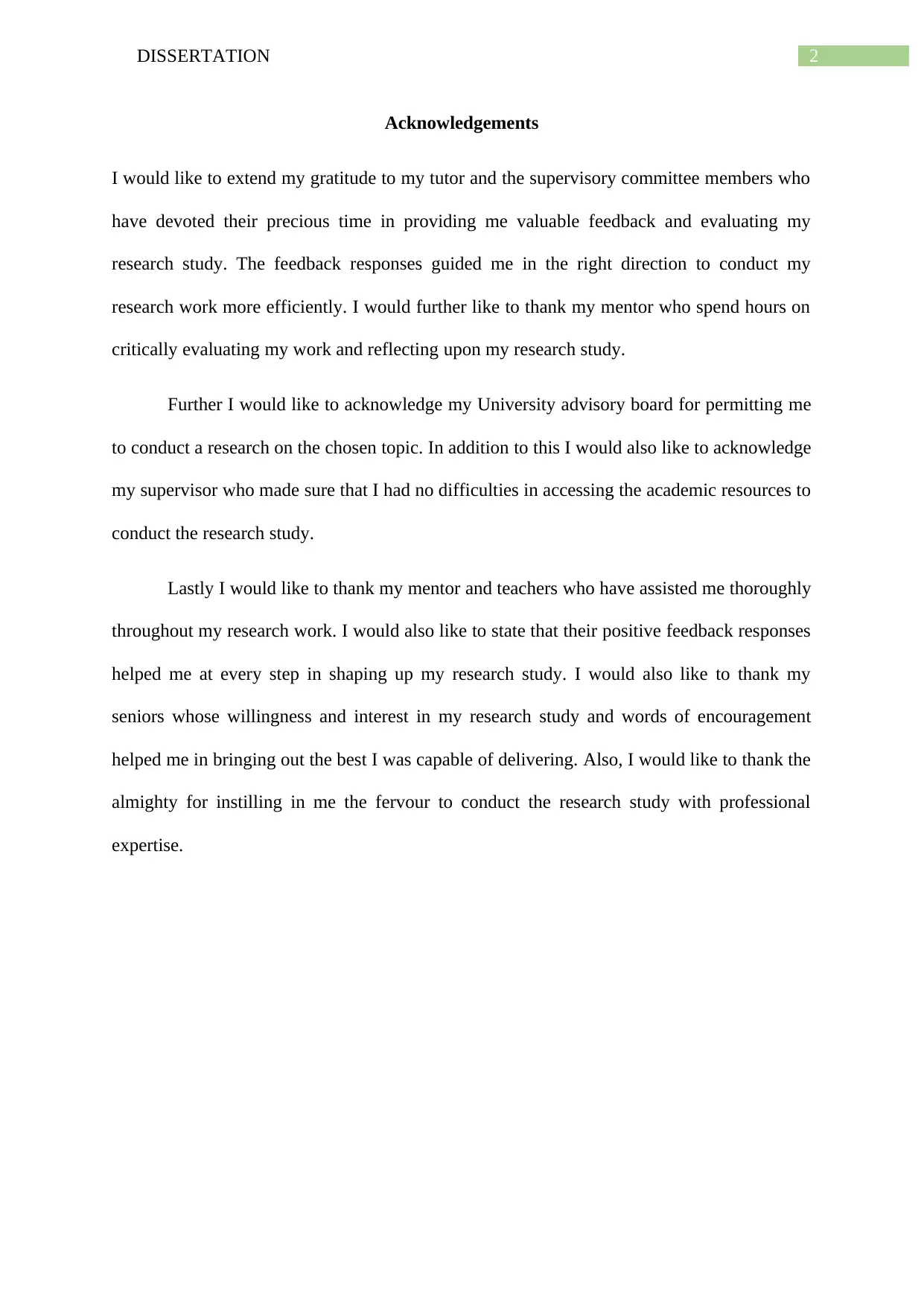
2DISSERTATION
Acknowledgements
I would like to extend my gratitude to my tutor and the supervisory committee members who
have devoted their precious time in providing me valuable feedback and evaluating my
research study. The feedback responses guided me in the right direction to conduct my
research work more efficiently. I would further like to thank my mentor who spend hours on
critically evaluating my work and reflecting upon my research study.
Further I would like to acknowledge my University advisory board for permitting me
to conduct a research on the chosen topic. In addition to this I would also like to acknowledge
my supervisor who made sure that I had no difficulties in accessing the academic resources to
conduct the research study.
Lastly I would like to thank my mentor and teachers who have assisted me thoroughly
throughout my research work. I would also like to state that their positive feedback responses
helped me at every step in shaping up my research study. I would also like to thank my
seniors whose willingness and interest in my research study and words of encouragement
helped me in bringing out the best I was capable of delivering. Also, I would like to thank the
almighty for instilling in me the fervour to conduct the research study with professional
expertise.
Acknowledgements
I would like to extend my gratitude to my tutor and the supervisory committee members who
have devoted their precious time in providing me valuable feedback and evaluating my
research study. The feedback responses guided me in the right direction to conduct my
research work more efficiently. I would further like to thank my mentor who spend hours on
critically evaluating my work and reflecting upon my research study.
Further I would like to acknowledge my University advisory board for permitting me
to conduct a research on the chosen topic. In addition to this I would also like to acknowledge
my supervisor who made sure that I had no difficulties in accessing the academic resources to
conduct the research study.
Lastly I would like to thank my mentor and teachers who have assisted me thoroughly
throughout my research work. I would also like to state that their positive feedback responses
helped me at every step in shaping up my research study. I would also like to thank my
seniors whose willingness and interest in my research study and words of encouragement
helped me in bringing out the best I was capable of delivering. Also, I would like to thank the
almighty for instilling in me the fervour to conduct the research study with professional
expertise.
⊘ This is a preview!⊘
Do you want full access?
Subscribe today to unlock all pages.

Trusted by 1+ million students worldwide
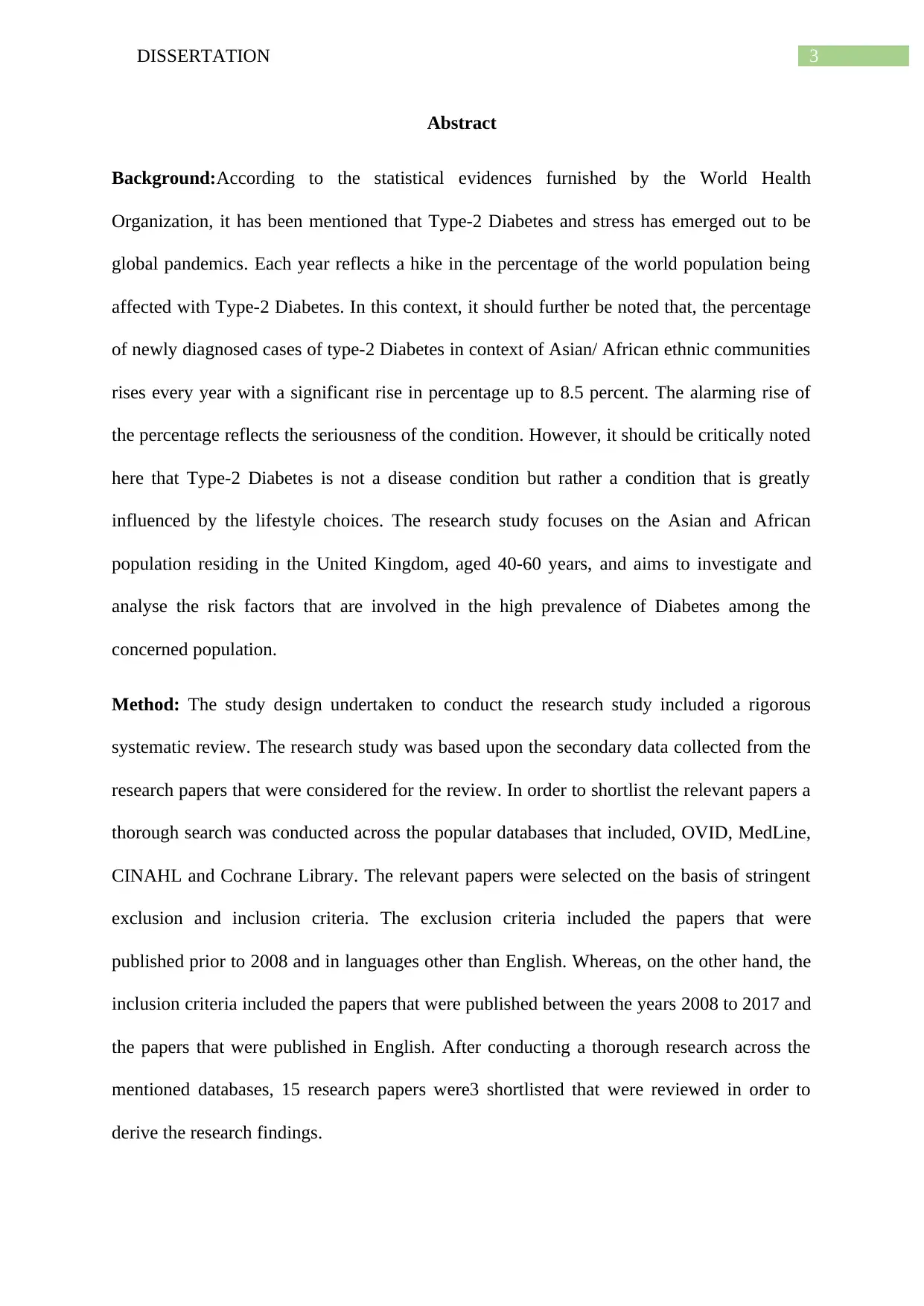
3DISSERTATION
Abstract
Background:According to the statistical evidences furnished by the World Health
Organization, it has been mentioned that Type-2 Diabetes and stress has emerged out to be
global pandemics. Each year reflects a hike in the percentage of the world population being
affected with Type-2 Diabetes. In this context, it should further be noted that, the percentage
of newly diagnosed cases of type-2 Diabetes in context of Asian/ African ethnic communities
rises every year with a significant rise in percentage up to 8.5 percent. The alarming rise of
the percentage reflects the seriousness of the condition. However, it should be critically noted
here that Type-2 Diabetes is not a disease condition but rather a condition that is greatly
influenced by the lifestyle choices. The research study focuses on the Asian and African
population residing in the United Kingdom, aged 40-60 years, and aims to investigate and
analyse the risk factors that are involved in the high prevalence of Diabetes among the
concerned population.
Method: The study design undertaken to conduct the research study included a rigorous
systematic review. The research study was based upon the secondary data collected from the
research papers that were considered for the review. In order to shortlist the relevant papers a
thorough search was conducted across the popular databases that included, OVID, MedLine,
CINAHL and Cochrane Library. The relevant papers were selected on the basis of stringent
exclusion and inclusion criteria. The exclusion criteria included the papers that were
published prior to 2008 and in languages other than English. Whereas, on the other hand, the
inclusion criteria included the papers that were published between the years 2008 to 2017 and
the papers that were published in English. After conducting a thorough research across the
mentioned databases, 15 research papers were3 shortlisted that were reviewed in order to
derive the research findings.
Abstract
Background:According to the statistical evidences furnished by the World Health
Organization, it has been mentioned that Type-2 Diabetes and stress has emerged out to be
global pandemics. Each year reflects a hike in the percentage of the world population being
affected with Type-2 Diabetes. In this context, it should further be noted that, the percentage
of newly diagnosed cases of type-2 Diabetes in context of Asian/ African ethnic communities
rises every year with a significant rise in percentage up to 8.5 percent. The alarming rise of
the percentage reflects the seriousness of the condition. However, it should be critically noted
here that Type-2 Diabetes is not a disease condition but rather a condition that is greatly
influenced by the lifestyle choices. The research study focuses on the Asian and African
population residing in the United Kingdom, aged 40-60 years, and aims to investigate and
analyse the risk factors that are involved in the high prevalence of Diabetes among the
concerned population.
Method: The study design undertaken to conduct the research study included a rigorous
systematic review. The research study was based upon the secondary data collected from the
research papers that were considered for the review. In order to shortlist the relevant papers a
thorough search was conducted across the popular databases that included, OVID, MedLine,
CINAHL and Cochrane Library. The relevant papers were selected on the basis of stringent
exclusion and inclusion criteria. The exclusion criteria included the papers that were
published prior to 2008 and in languages other than English. Whereas, on the other hand, the
inclusion criteria included the papers that were published between the years 2008 to 2017 and
the papers that were published in English. After conducting a thorough research across the
mentioned databases, 15 research papers were3 shortlisted that were reviewed in order to
derive the research findings.
Paraphrase This Document
Need a fresh take? Get an instant paraphrase of this document with our AI Paraphraser
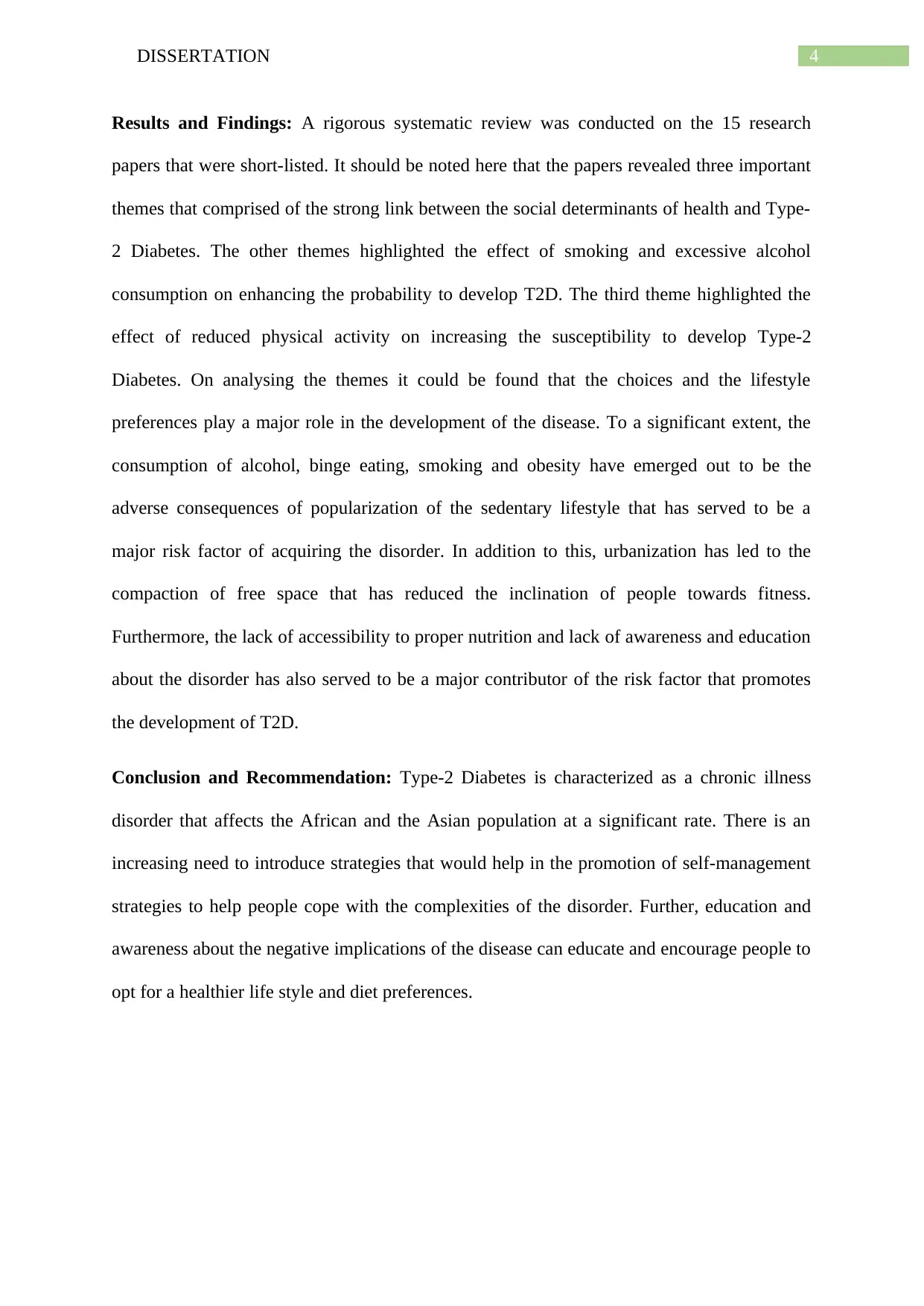
4DISSERTATION
Results and Findings: A rigorous systematic review was conducted on the 15 research
papers that were short-listed. It should be noted here that the papers revealed three important
themes that comprised of the strong link between the social determinants of health and Type-
2 Diabetes. The other themes highlighted the effect of smoking and excessive alcohol
consumption on enhancing the probability to develop T2D. The third theme highlighted the
effect of reduced physical activity on increasing the susceptibility to develop Type-2
Diabetes. On analysing the themes it could be found that the choices and the lifestyle
preferences play a major role in the development of the disease. To a significant extent, the
consumption of alcohol, binge eating, smoking and obesity have emerged out to be the
adverse consequences of popularization of the sedentary lifestyle that has served to be a
major risk factor of acquiring the disorder. In addition to this, urbanization has led to the
compaction of free space that has reduced the inclination of people towards fitness.
Furthermore, the lack of accessibility to proper nutrition and lack of awareness and education
about the disorder has also served to be a major contributor of the risk factor that promotes
the development of T2D.
Conclusion and Recommendation: Type-2 Diabetes is characterized as a chronic illness
disorder that affects the African and the Asian population at a significant rate. There is an
increasing need to introduce strategies that would help in the promotion of self-management
strategies to help people cope with the complexities of the disorder. Further, education and
awareness about the negative implications of the disease can educate and encourage people to
opt for a healthier life style and diet preferences.
Results and Findings: A rigorous systematic review was conducted on the 15 research
papers that were short-listed. It should be noted here that the papers revealed three important
themes that comprised of the strong link between the social determinants of health and Type-
2 Diabetes. The other themes highlighted the effect of smoking and excessive alcohol
consumption on enhancing the probability to develop T2D. The third theme highlighted the
effect of reduced physical activity on increasing the susceptibility to develop Type-2
Diabetes. On analysing the themes it could be found that the choices and the lifestyle
preferences play a major role in the development of the disease. To a significant extent, the
consumption of alcohol, binge eating, smoking and obesity have emerged out to be the
adverse consequences of popularization of the sedentary lifestyle that has served to be a
major risk factor of acquiring the disorder. In addition to this, urbanization has led to the
compaction of free space that has reduced the inclination of people towards fitness.
Furthermore, the lack of accessibility to proper nutrition and lack of awareness and education
about the disorder has also served to be a major contributor of the risk factor that promotes
the development of T2D.
Conclusion and Recommendation: Type-2 Diabetes is characterized as a chronic illness
disorder that affects the African and the Asian population at a significant rate. There is an
increasing need to introduce strategies that would help in the promotion of self-management
strategies to help people cope with the complexities of the disorder. Further, education and
awareness about the negative implications of the disease can educate and encourage people to
opt for a healthier life style and diet preferences.
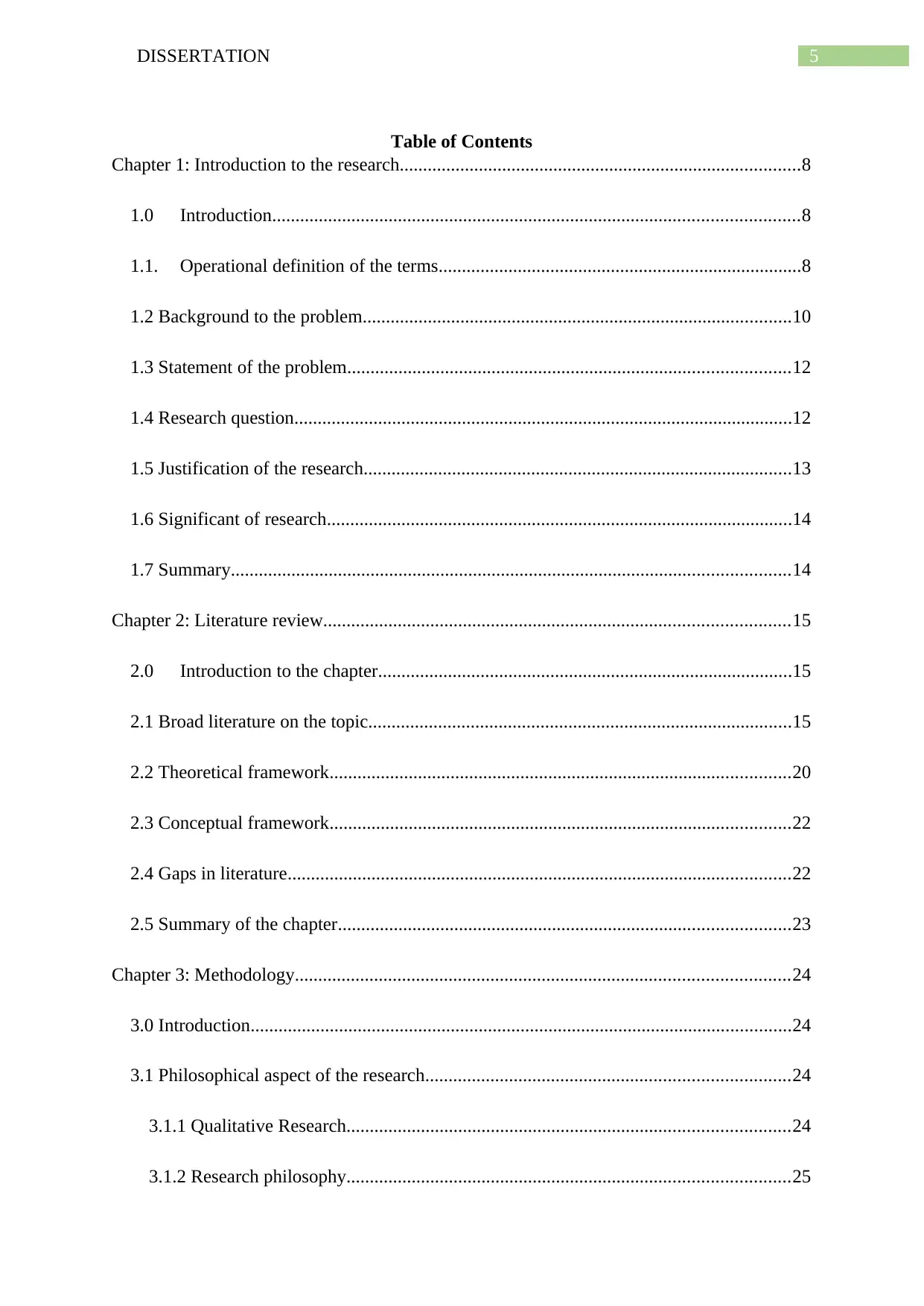
5DISSERTATION
Table of Contents
Chapter 1: Introduction to the research......................................................................................8
1.0 Introduction.................................................................................................................8
1.1. Operational definition of the terms..............................................................................8
1.2 Background to the problem............................................................................................10
1.3 Statement of the problem...............................................................................................12
1.4 Research question...........................................................................................................12
1.5 Justification of the research............................................................................................13
1.6 Significant of research....................................................................................................14
1.7 Summary........................................................................................................................14
Chapter 2: Literature review....................................................................................................15
2.0 Introduction to the chapter.........................................................................................15
2.1 Broad literature on the topic...........................................................................................15
2.2 Theoretical framework...................................................................................................20
2.3 Conceptual framework...................................................................................................22
2.4 Gaps in literature............................................................................................................22
2.5 Summary of the chapter.................................................................................................23
Chapter 3: Methodology..........................................................................................................24
3.0 Introduction....................................................................................................................24
3.1 Philosophical aspect of the research..............................................................................24
3.1.1 Qualitative Research...............................................................................................24
3.1.2 Research philosophy...............................................................................................25
Table of Contents
Chapter 1: Introduction to the research......................................................................................8
1.0 Introduction.................................................................................................................8
1.1. Operational definition of the terms..............................................................................8
1.2 Background to the problem............................................................................................10
1.3 Statement of the problem...............................................................................................12
1.4 Research question...........................................................................................................12
1.5 Justification of the research............................................................................................13
1.6 Significant of research....................................................................................................14
1.7 Summary........................................................................................................................14
Chapter 2: Literature review....................................................................................................15
2.0 Introduction to the chapter.........................................................................................15
2.1 Broad literature on the topic...........................................................................................15
2.2 Theoretical framework...................................................................................................20
2.3 Conceptual framework...................................................................................................22
2.4 Gaps in literature............................................................................................................22
2.5 Summary of the chapter.................................................................................................23
Chapter 3: Methodology..........................................................................................................24
3.0 Introduction....................................................................................................................24
3.1 Philosophical aspect of the research..............................................................................24
3.1.1 Qualitative Research...............................................................................................24
3.1.2 Research philosophy...............................................................................................25
⊘ This is a preview!⊘
Do you want full access?
Subscribe today to unlock all pages.

Trusted by 1+ million students worldwide
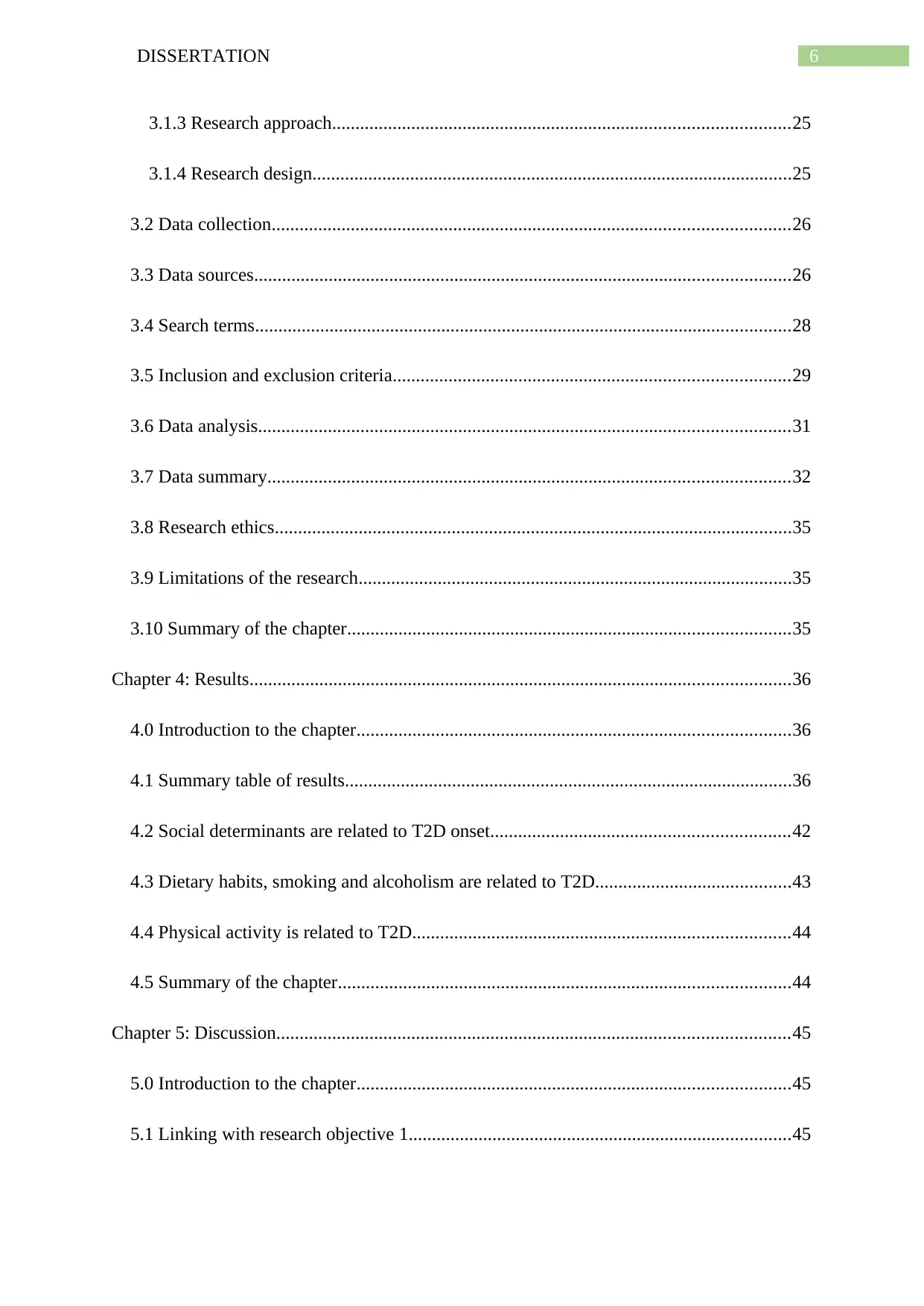
6DISSERTATION
3.1.3 Research approach..................................................................................................25
3.1.4 Research design.......................................................................................................25
3.2 Data collection...............................................................................................................26
3.3 Data sources...................................................................................................................26
3.4 Search terms...................................................................................................................28
3.5 Inclusion and exclusion criteria.....................................................................................29
3.6 Data analysis..................................................................................................................31
3.7 Data summary................................................................................................................32
3.8 Research ethics...............................................................................................................35
3.9 Limitations of the research.............................................................................................35
3.10 Summary of the chapter...............................................................................................35
Chapter 4: Results....................................................................................................................36
4.0 Introduction to the chapter.............................................................................................36
4.1 Summary table of results................................................................................................36
4.2 Social determinants are related to T2D onset................................................................42
4.3 Dietary habits, smoking and alcoholism are related to T2D..........................................43
4.4 Physical activity is related to T2D.................................................................................44
4.5 Summary of the chapter.................................................................................................44
Chapter 5: Discussion..............................................................................................................45
5.0 Introduction to the chapter.............................................................................................45
5.1 Linking with research objective 1..................................................................................45
3.1.3 Research approach..................................................................................................25
3.1.4 Research design.......................................................................................................25
3.2 Data collection...............................................................................................................26
3.3 Data sources...................................................................................................................26
3.4 Search terms...................................................................................................................28
3.5 Inclusion and exclusion criteria.....................................................................................29
3.6 Data analysis..................................................................................................................31
3.7 Data summary................................................................................................................32
3.8 Research ethics...............................................................................................................35
3.9 Limitations of the research.............................................................................................35
3.10 Summary of the chapter...............................................................................................35
Chapter 4: Results....................................................................................................................36
4.0 Introduction to the chapter.............................................................................................36
4.1 Summary table of results................................................................................................36
4.2 Social determinants are related to T2D onset................................................................42
4.3 Dietary habits, smoking and alcoholism are related to T2D..........................................43
4.4 Physical activity is related to T2D.................................................................................44
4.5 Summary of the chapter.................................................................................................44
Chapter 5: Discussion..............................................................................................................45
5.0 Introduction to the chapter.............................................................................................45
5.1 Linking with research objective 1..................................................................................45
Paraphrase This Document
Need a fresh take? Get an instant paraphrase of this document with our AI Paraphraser
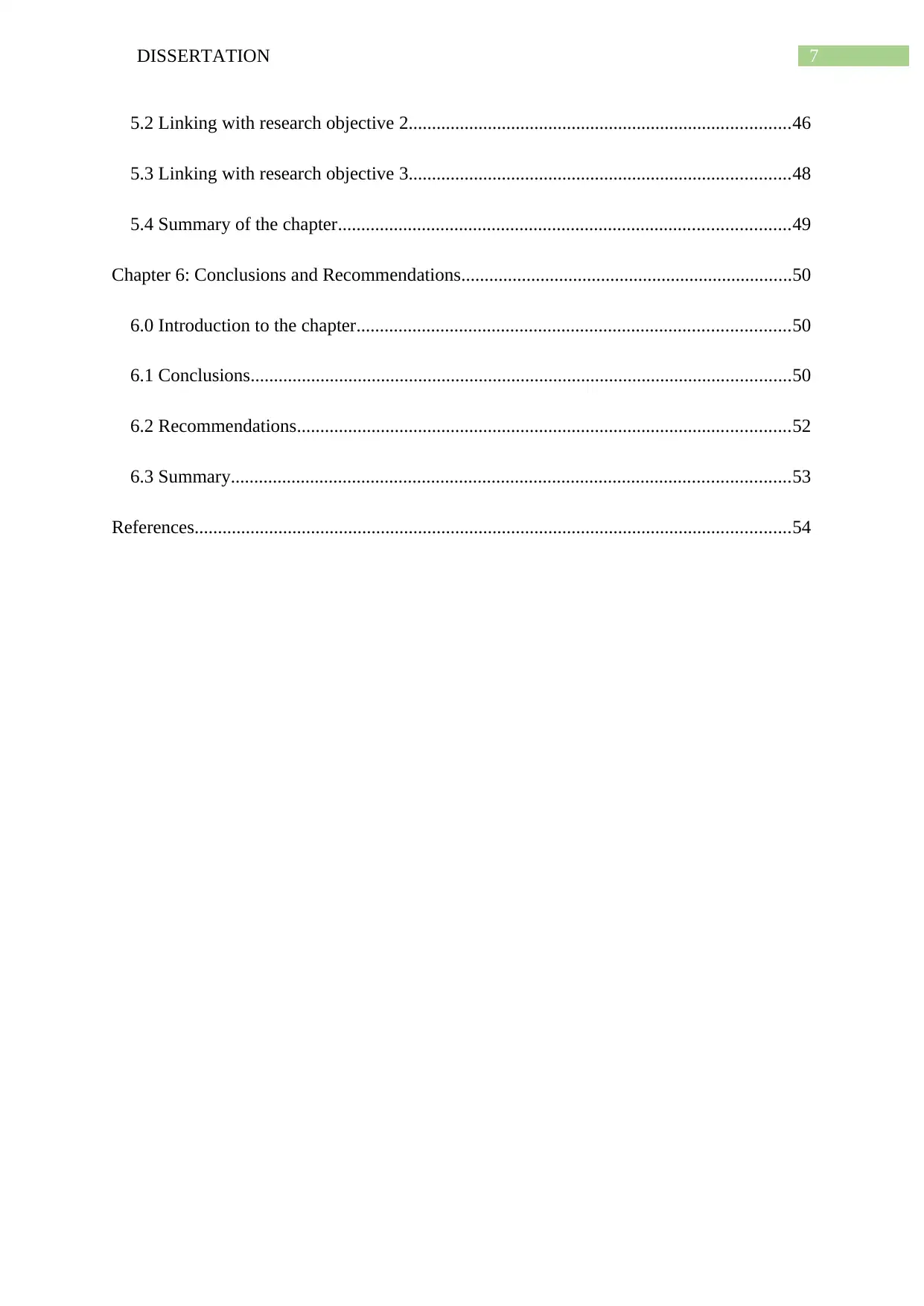
7DISSERTATION
5.2 Linking with research objective 2..................................................................................46
5.3 Linking with research objective 3..................................................................................48
5.4 Summary of the chapter.................................................................................................49
Chapter 6: Conclusions and Recommendations.......................................................................50
6.0 Introduction to the chapter.............................................................................................50
6.1 Conclusions....................................................................................................................50
6.2 Recommendations..........................................................................................................52
6.3 Summary........................................................................................................................53
References................................................................................................................................54
5.2 Linking with research objective 2..................................................................................46
5.3 Linking with research objective 3..................................................................................48
5.4 Summary of the chapter.................................................................................................49
Chapter 6: Conclusions and Recommendations.......................................................................50
6.0 Introduction to the chapter.............................................................................................50
6.1 Conclusions....................................................................................................................50
6.2 Recommendations..........................................................................................................52
6.3 Summary........................................................................................................................53
References................................................................................................................................54
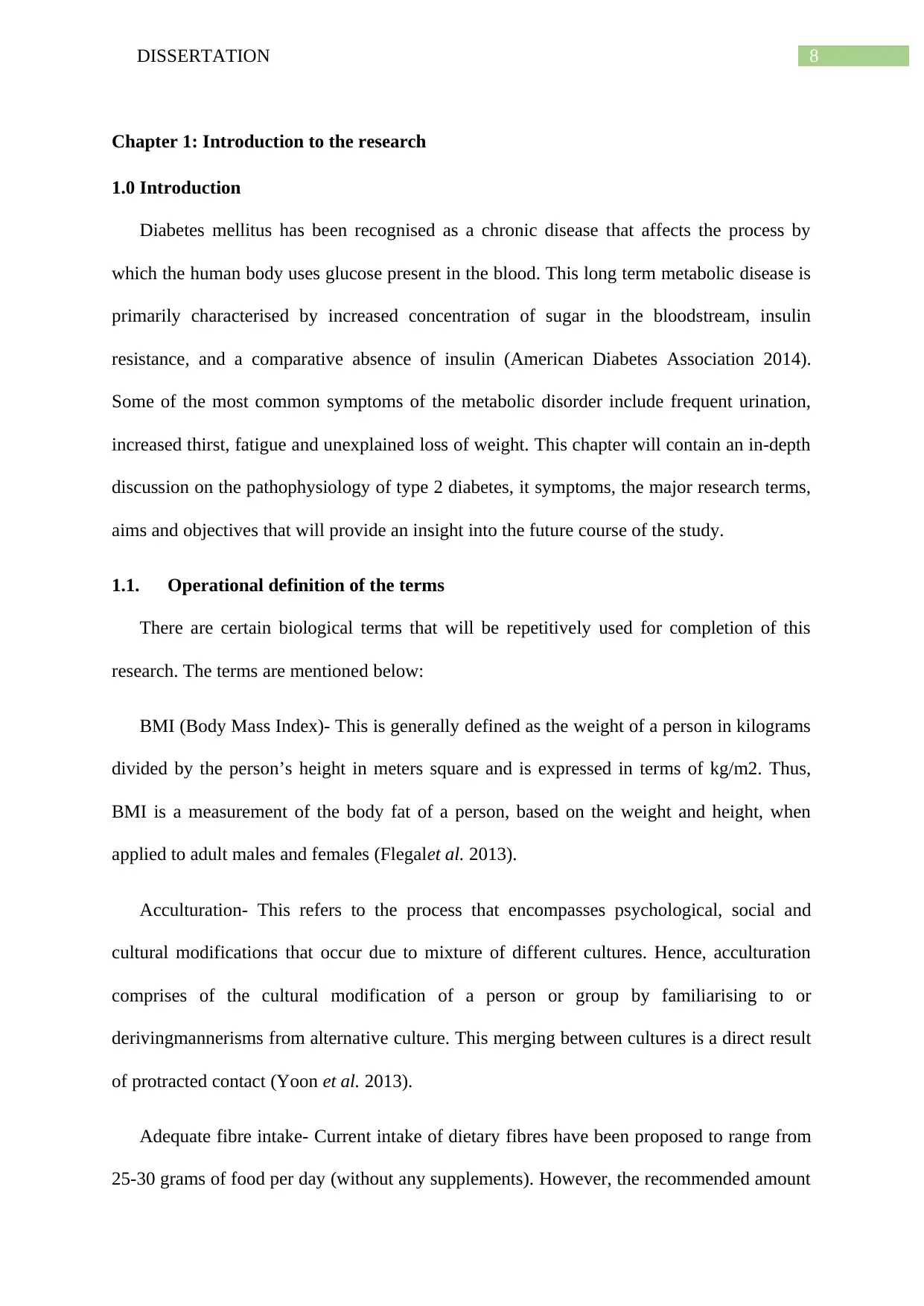
8DISSERTATION
Chapter 1: Introduction to the research
1.0 Introduction
Diabetes mellitus has been recognised as a chronic disease that affects the process by
which the human body uses glucose present in the blood. This long term metabolic disease is
primarily characterised by increased concentration of sugar in the bloodstream, insulin
resistance, and a comparative absence of insulin (American Diabetes Association 2014).
Some of the most common symptoms of the metabolic disorder include frequent urination,
increased thirst, fatigue and unexplained loss of weight. This chapter will contain an in-depth
discussion on the pathophysiology of type 2 diabetes, it symptoms, the major research terms,
aims and objectives that will provide an insight into the future course of the study.
1.1. Operational definition of the terms
There are certain biological terms that will be repetitively used for completion of this
research. The terms are mentioned below:
BMI (Body Mass Index)- This is generally defined as the weight of a person in kilograms
divided by the person’s height in meters square and is expressed in terms of kg/m2. Thus,
BMI is a measurement of the body fat of a person, based on the weight and height, when
applied to adult males and females (Flegalet al. 2013).
Acculturation- This refers to the process that encompasses psychological, social and
cultural modifications that occur due to mixture of different cultures. Hence, acculturation
comprises of the cultural modification of a person or group by familiarising to or
derivingmannerisms from alternative culture. This merging between cultures is a direct result
of protracted contact (Yoon et al. 2013).
Adequate fibre intake- Current intake of dietary fibres have been proposed to range from
25-30 grams of food per day (without any supplements). However, the recommended amount
Chapter 1: Introduction to the research
1.0 Introduction
Diabetes mellitus has been recognised as a chronic disease that affects the process by
which the human body uses glucose present in the blood. This long term metabolic disease is
primarily characterised by increased concentration of sugar in the bloodstream, insulin
resistance, and a comparative absence of insulin (American Diabetes Association 2014).
Some of the most common symptoms of the metabolic disorder include frequent urination,
increased thirst, fatigue and unexplained loss of weight. This chapter will contain an in-depth
discussion on the pathophysiology of type 2 diabetes, it symptoms, the major research terms,
aims and objectives that will provide an insight into the future course of the study.
1.1. Operational definition of the terms
There are certain biological terms that will be repetitively used for completion of this
research. The terms are mentioned below:
BMI (Body Mass Index)- This is generally defined as the weight of a person in kilograms
divided by the person’s height in meters square and is expressed in terms of kg/m2. Thus,
BMI is a measurement of the body fat of a person, based on the weight and height, when
applied to adult males and females (Flegalet al. 2013).
Acculturation- This refers to the process that encompasses psychological, social and
cultural modifications that occur due to mixture of different cultures. Hence, acculturation
comprises of the cultural modification of a person or group by familiarising to or
derivingmannerisms from alternative culture. This merging between cultures is a direct result
of protracted contact (Yoon et al. 2013).
Adequate fibre intake- Current intake of dietary fibres have been proposed to range from
25-30 grams of food per day (without any supplements). However, the recommended amount
⊘ This is a preview!⊘
Do you want full access?
Subscribe today to unlock all pages.

Trusted by 1+ million students worldwide
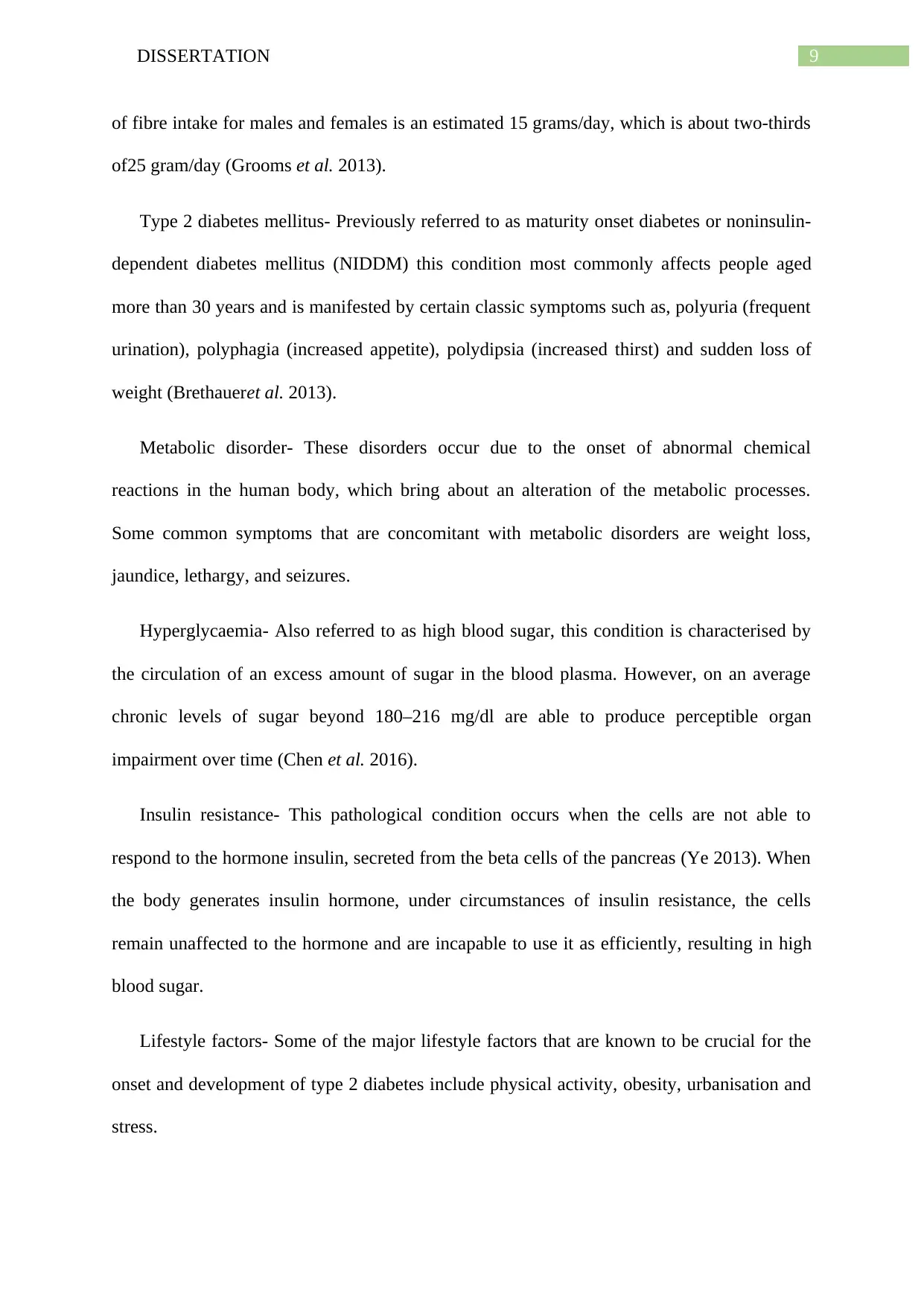
9DISSERTATION
of fibre intake for males and females is an estimated 15 grams/day, which is about two-thirds
of25 gram/day (Grooms et al. 2013).
Type 2 diabetes mellitus- Previously referred to as maturity onset diabetes or noninsulin-
dependent diabetes mellitus (NIDDM) this condition most commonly affects people aged
more than 30 years and is manifested by certain classic symptoms such as, polyuria (frequent
urination), polyphagia (increased appetite), polydipsia (increased thirst) and sudden loss of
weight (Brethaueret al. 2013).
Metabolic disorder- These disorders occur due to the onset of abnormal chemical
reactions in the human body, which bring about an alteration of the metabolic processes.
Some common symptoms that are concomitant with metabolic disorders are weight loss,
jaundice, lethargy, and seizures.
Hyperglycaemia- Also referred to as high blood sugar, this condition is characterised by
the circulation of an excess amount of sugar in the blood plasma. However, on an average
chronic levels of sugar beyond 180–216 mg/dl are able to produce perceptible organ
impairment over time (Chen et al. 2016).
Insulin resistance- This pathological condition occurs when the cells are not able to
respond to the hormone insulin, secreted from the beta cells of the pancreas (Ye 2013). When
the body generates insulin hormone, under circumstances of insulin resistance, the cells
remain unaffected to the hormone and are incapable to use it as efficiently, resulting in high
blood sugar.
Lifestyle factors- Some of the major lifestyle factors that are known to be crucial for the
onset and development of type 2 diabetes include physical activity, obesity, urbanisation and
stress.
of fibre intake for males and females is an estimated 15 grams/day, which is about two-thirds
of25 gram/day (Grooms et al. 2013).
Type 2 diabetes mellitus- Previously referred to as maturity onset diabetes or noninsulin-
dependent diabetes mellitus (NIDDM) this condition most commonly affects people aged
more than 30 years and is manifested by certain classic symptoms such as, polyuria (frequent
urination), polyphagia (increased appetite), polydipsia (increased thirst) and sudden loss of
weight (Brethaueret al. 2013).
Metabolic disorder- These disorders occur due to the onset of abnormal chemical
reactions in the human body, which bring about an alteration of the metabolic processes.
Some common symptoms that are concomitant with metabolic disorders are weight loss,
jaundice, lethargy, and seizures.
Hyperglycaemia- Also referred to as high blood sugar, this condition is characterised by
the circulation of an excess amount of sugar in the blood plasma. However, on an average
chronic levels of sugar beyond 180–216 mg/dl are able to produce perceptible organ
impairment over time (Chen et al. 2016).
Insulin resistance- This pathological condition occurs when the cells are not able to
respond to the hormone insulin, secreted from the beta cells of the pancreas (Ye 2013). When
the body generates insulin hormone, under circumstances of insulin resistance, the cells
remain unaffected to the hormone and are incapable to use it as efficiently, resulting in high
blood sugar.
Lifestyle factors- Some of the major lifestyle factors that are known to be crucial for the
onset and development of type 2 diabetes include physical activity, obesity, urbanisation and
stress.
Paraphrase This Document
Need a fresh take? Get an instant paraphrase of this document with our AI Paraphraser
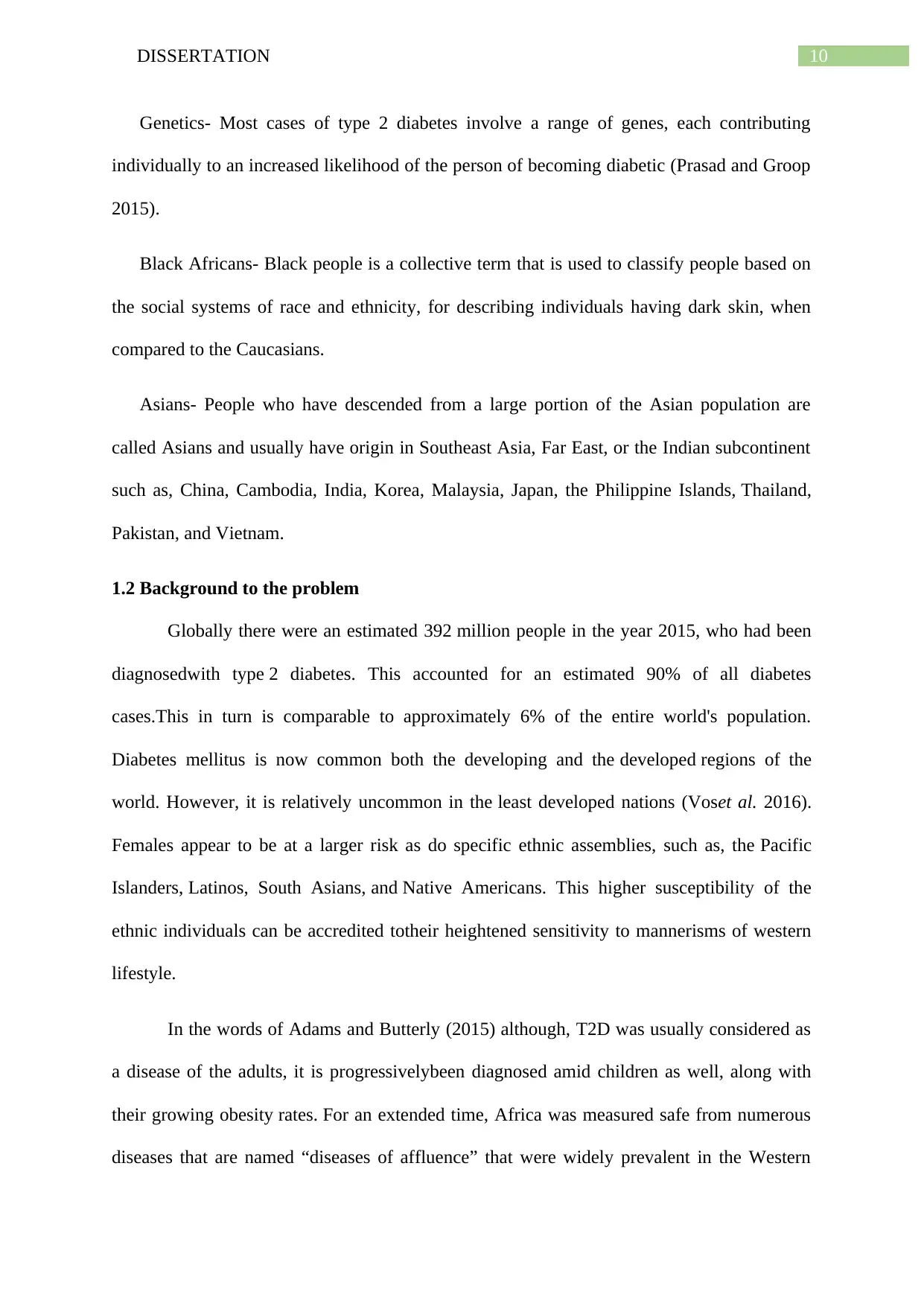
10DISSERTATION
Genetics- Most cases of type 2 diabetes involve a range of genes, each contributing
individually to an increased likelihood of the person of becoming diabetic (Prasad and Groop
2015).
Black Africans- Black people is a collective term that is used to classify people based on
the social systems of race and ethnicity, for describing individuals having dark skin, when
compared to the Caucasians.
Asians- People who have descended from a large portion of the Asian population are
called Asians and usually have origin in Southeast Asia, Far East, or the Indian subcontinent
such as, China, Cambodia, India, Korea, Malaysia, Japan, the Philippine Islands, Thailand,
Pakistan, and Vietnam.
1.2 Background to the problem
Globally there were an estimated 392 million people in the year 2015, who had been
diagnosedwith type 2 diabetes. This accounted for an estimated 90% of all diabetes
cases.This in turn is comparable to approximately 6% of the entire world's population.
Diabetes mellitus is now common both the developing and the developed regions of the
world. However, it is relatively uncommon in the least developed nations (Voset al. 2016).
Females appear to be at a larger risk as do specific ethnic assemblies, such as, the Pacific
Islanders, Latinos, South Asians, and Native Americans. This higher susceptibility of the
ethnic individuals can be accredited totheir heightened sensitivity to mannerisms of western
lifestyle.
In the words of Adams and Butterly (2015) although, T2D was usually considered as
a disease of the adults, it is progressivelybeen diagnosed amid children as well, along with
their growing obesity rates. For an extended time, Africa was measured safe from numerous
diseases that are named “diseases of affluence” that were widely prevalent in the Western
Genetics- Most cases of type 2 diabetes involve a range of genes, each contributing
individually to an increased likelihood of the person of becoming diabetic (Prasad and Groop
2015).
Black Africans- Black people is a collective term that is used to classify people based on
the social systems of race and ethnicity, for describing individuals having dark skin, when
compared to the Caucasians.
Asians- People who have descended from a large portion of the Asian population are
called Asians and usually have origin in Southeast Asia, Far East, or the Indian subcontinent
such as, China, Cambodia, India, Korea, Malaysia, Japan, the Philippine Islands, Thailand,
Pakistan, and Vietnam.
1.2 Background to the problem
Globally there were an estimated 392 million people in the year 2015, who had been
diagnosedwith type 2 diabetes. This accounted for an estimated 90% of all diabetes
cases.This in turn is comparable to approximately 6% of the entire world's population.
Diabetes mellitus is now common both the developing and the developed regions of the
world. However, it is relatively uncommon in the least developed nations (Voset al. 2016).
Females appear to be at a larger risk as do specific ethnic assemblies, such as, the Pacific
Islanders, Latinos, South Asians, and Native Americans. This higher susceptibility of the
ethnic individuals can be accredited totheir heightened sensitivity to mannerisms of western
lifestyle.
In the words of Adams and Butterly (2015) although, T2D was usually considered as
a disease of the adults, it is progressivelybeen diagnosed amid children as well, along with
their growing obesity rates. For an extended time, Africa was measured safe from numerous
diseases that are named “diseases of affluence” that were widely prevalent in the Western
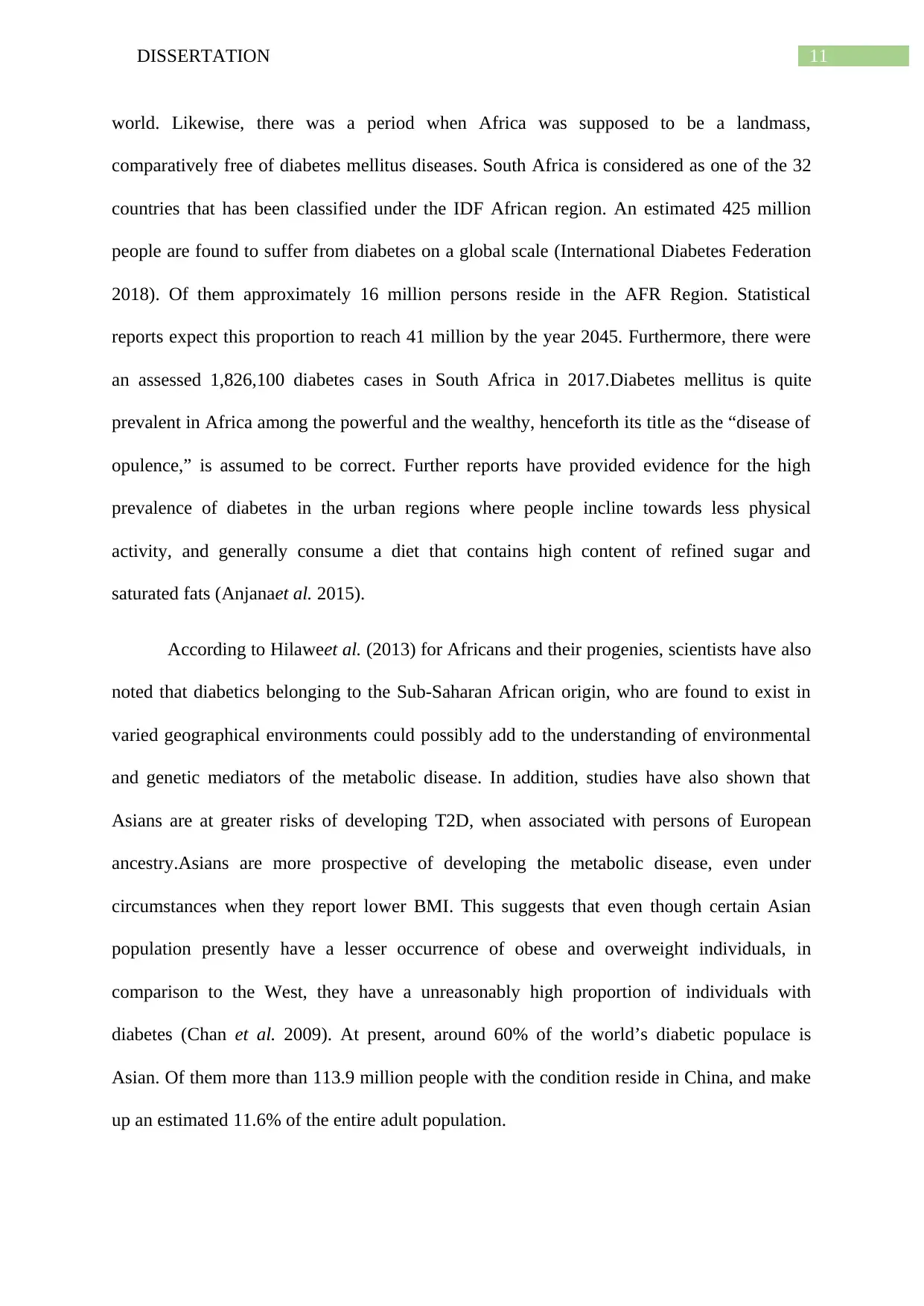
11DISSERTATION
world. Likewise, there was a period when Africa was supposed to be a landmass,
comparatively free of diabetes mellitus diseases. South Africa is considered as one of the 32
countries that has been classified under the IDF African region. An estimated 425 million
people are found to suffer from diabetes on a global scale (International Diabetes Federation
2018). Of them approximately 16 million persons reside in the AFR Region. Statistical
reports expect this proportion to reach 41 million by the year 2045. Furthermore, there were
an assessed 1,826,100 diabetes cases in South Africa in 2017.Diabetes mellitus is quite
prevalent in Africa among the powerful and the wealthy, henceforth its title as the “disease of
opulence,” is assumed to be correct. Further reports have provided evidence for the high
prevalence of diabetes in the urban regions where people incline towards less physical
activity, and generally consume a diet that contains high content of refined sugar and
saturated fats (Anjanaet al. 2015).
According to Hilaweet al. (2013) for Africans and their progenies, scientists have also
noted that diabetics belonging to the Sub-Saharan African origin, who are found to exist in
varied geographical environments could possibly add to the understanding of environmental
and genetic mediators of the metabolic disease. In addition, studies have also shown that
Asians are at greater risks of developing T2D, when associated with persons of European
ancestry.Asians are more prospective of developing the metabolic disease, even under
circumstances when they report lower BMI. This suggests that even though certain Asian
population presently have a lesser occurrence of obese and overweight individuals, in
comparison to the West, they have a unreasonably high proportion of individuals with
diabetes (Chan et al. 2009). At present, around 60% of the world’s diabetic populace is
Asian. Of them more than 113.9 million people with the condition reside in China, and make
up an estimated 11.6% of the entire adult population.
world. Likewise, there was a period when Africa was supposed to be a landmass,
comparatively free of diabetes mellitus diseases. South Africa is considered as one of the 32
countries that has been classified under the IDF African region. An estimated 425 million
people are found to suffer from diabetes on a global scale (International Diabetes Federation
2018). Of them approximately 16 million persons reside in the AFR Region. Statistical
reports expect this proportion to reach 41 million by the year 2045. Furthermore, there were
an assessed 1,826,100 diabetes cases in South Africa in 2017.Diabetes mellitus is quite
prevalent in Africa among the powerful and the wealthy, henceforth its title as the “disease of
opulence,” is assumed to be correct. Further reports have provided evidence for the high
prevalence of diabetes in the urban regions where people incline towards less physical
activity, and generally consume a diet that contains high content of refined sugar and
saturated fats (Anjanaet al. 2015).
According to Hilaweet al. (2013) for Africans and their progenies, scientists have also
noted that diabetics belonging to the Sub-Saharan African origin, who are found to exist in
varied geographical environments could possibly add to the understanding of environmental
and genetic mediators of the metabolic disease. In addition, studies have also shown that
Asians are at greater risks of developing T2D, when associated with persons of European
ancestry.Asians are more prospective of developing the metabolic disease, even under
circumstances when they report lower BMI. This suggests that even though certain Asian
population presently have a lesser occurrence of obese and overweight individuals, in
comparison to the West, they have a unreasonably high proportion of individuals with
diabetes (Chan et al. 2009). At present, around 60% of the world’s diabetic populace is
Asian. Of them more than 113.9 million people with the condition reside in China, and make
up an estimated 11.6% of the entire adult population.
⊘ This is a preview!⊘
Do you want full access?
Subscribe today to unlock all pages.

Trusted by 1+ million students worldwide
1 out of 61
Related Documents
Your All-in-One AI-Powered Toolkit for Academic Success.
+13062052269
info@desklib.com
Available 24*7 on WhatsApp / Email
![[object Object]](/_next/static/media/star-bottom.7253800d.svg)
Unlock your academic potential
Copyright © 2020–2025 A2Z Services. All Rights Reserved. Developed and managed by ZUCOL.




